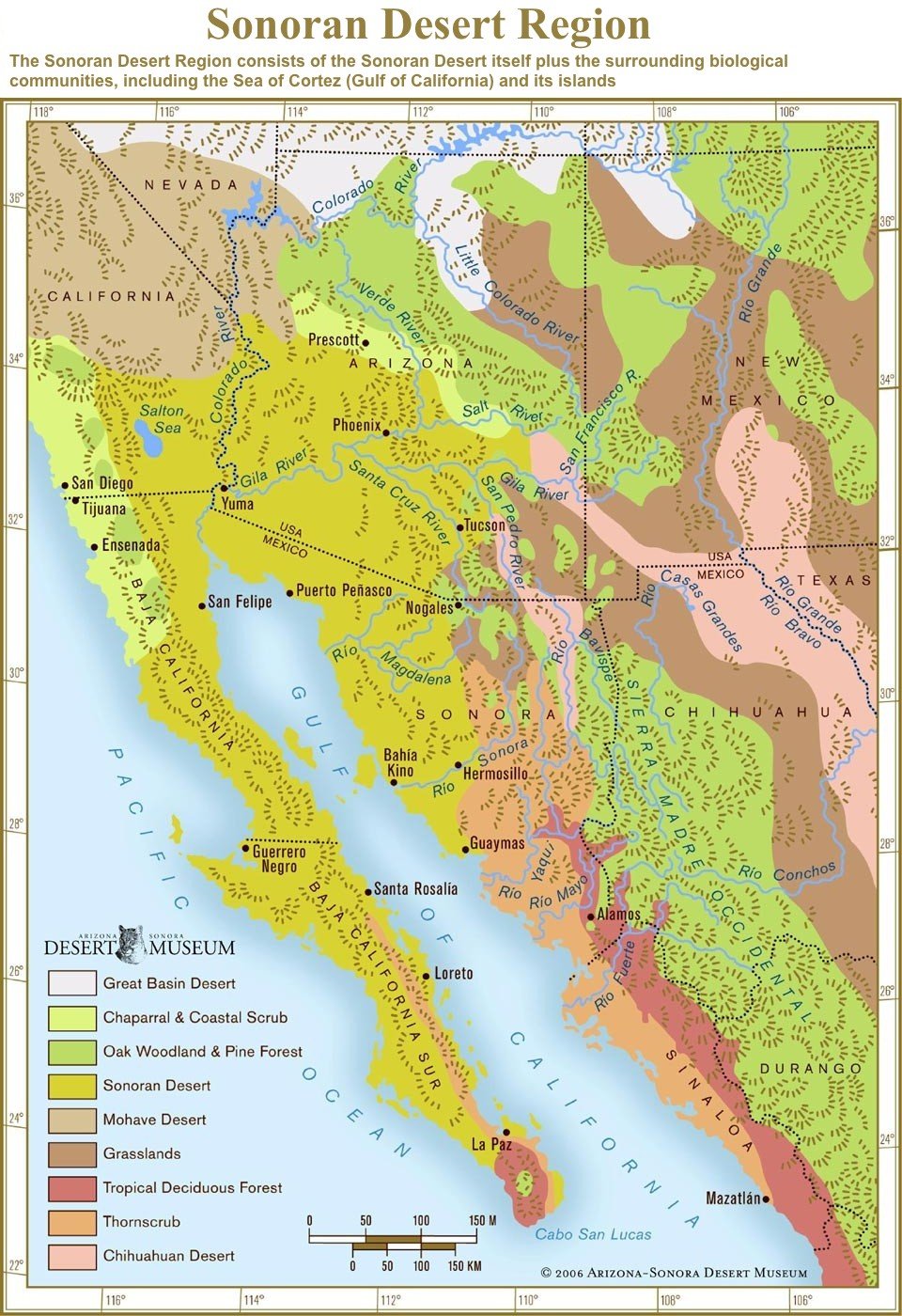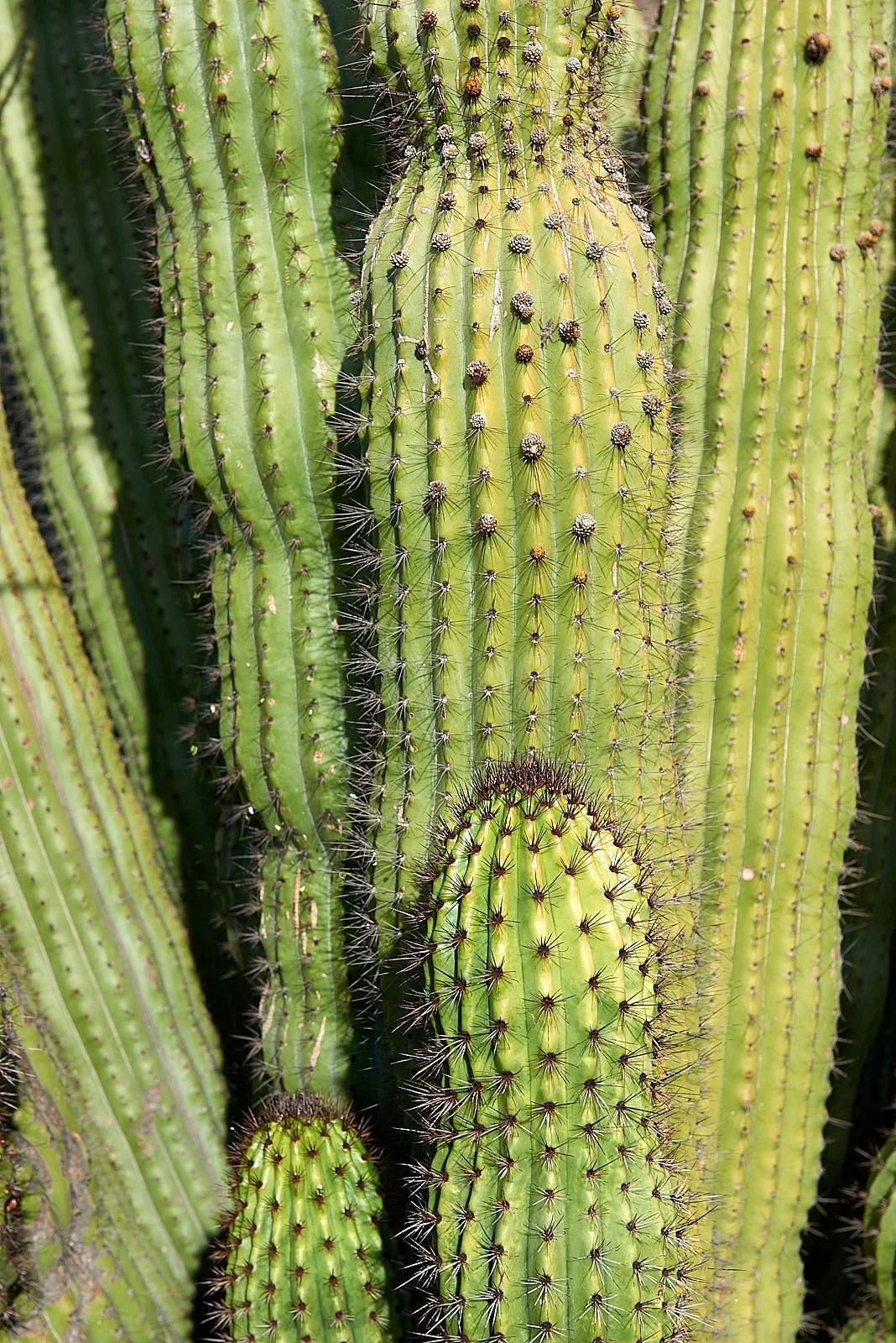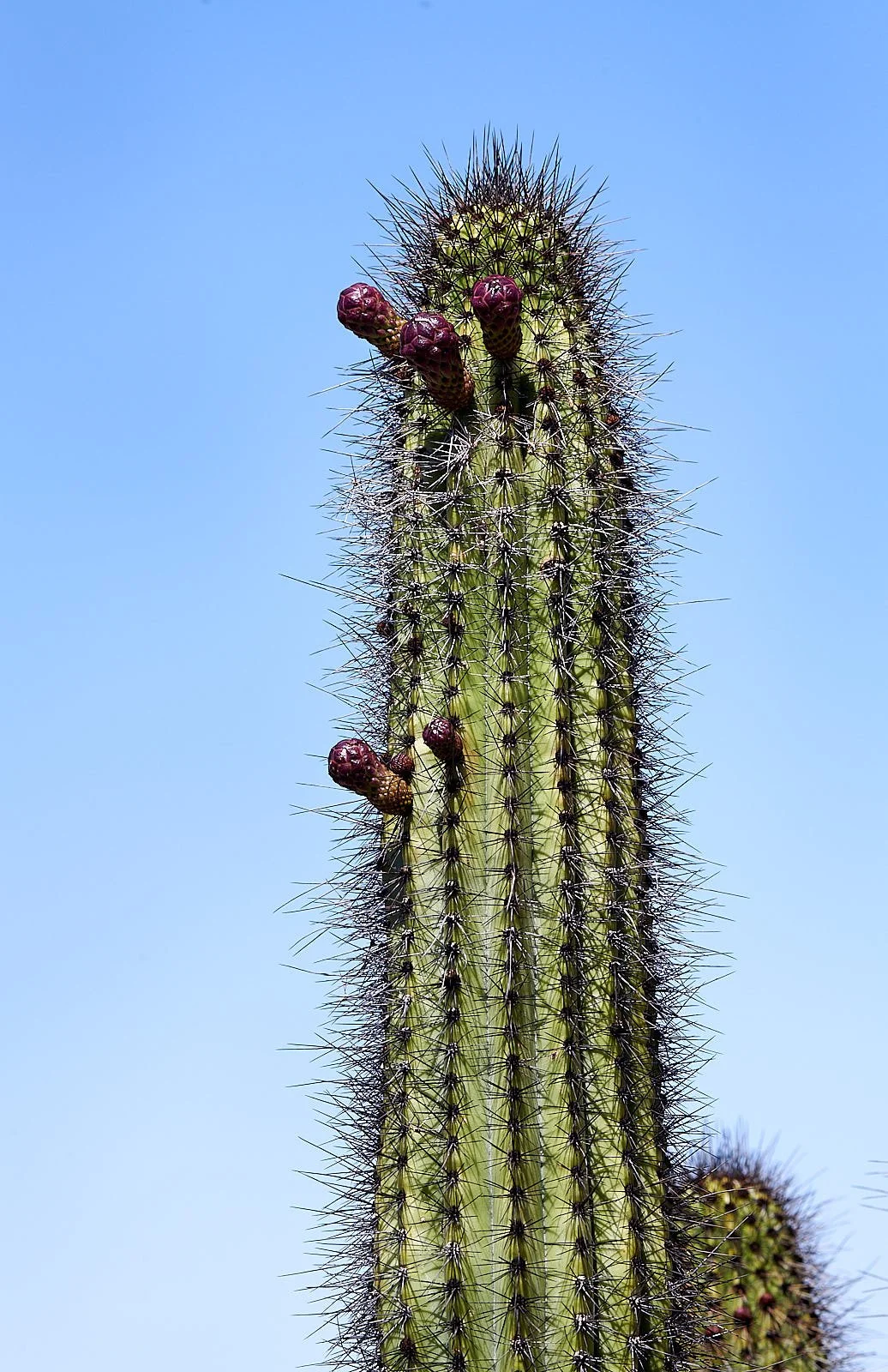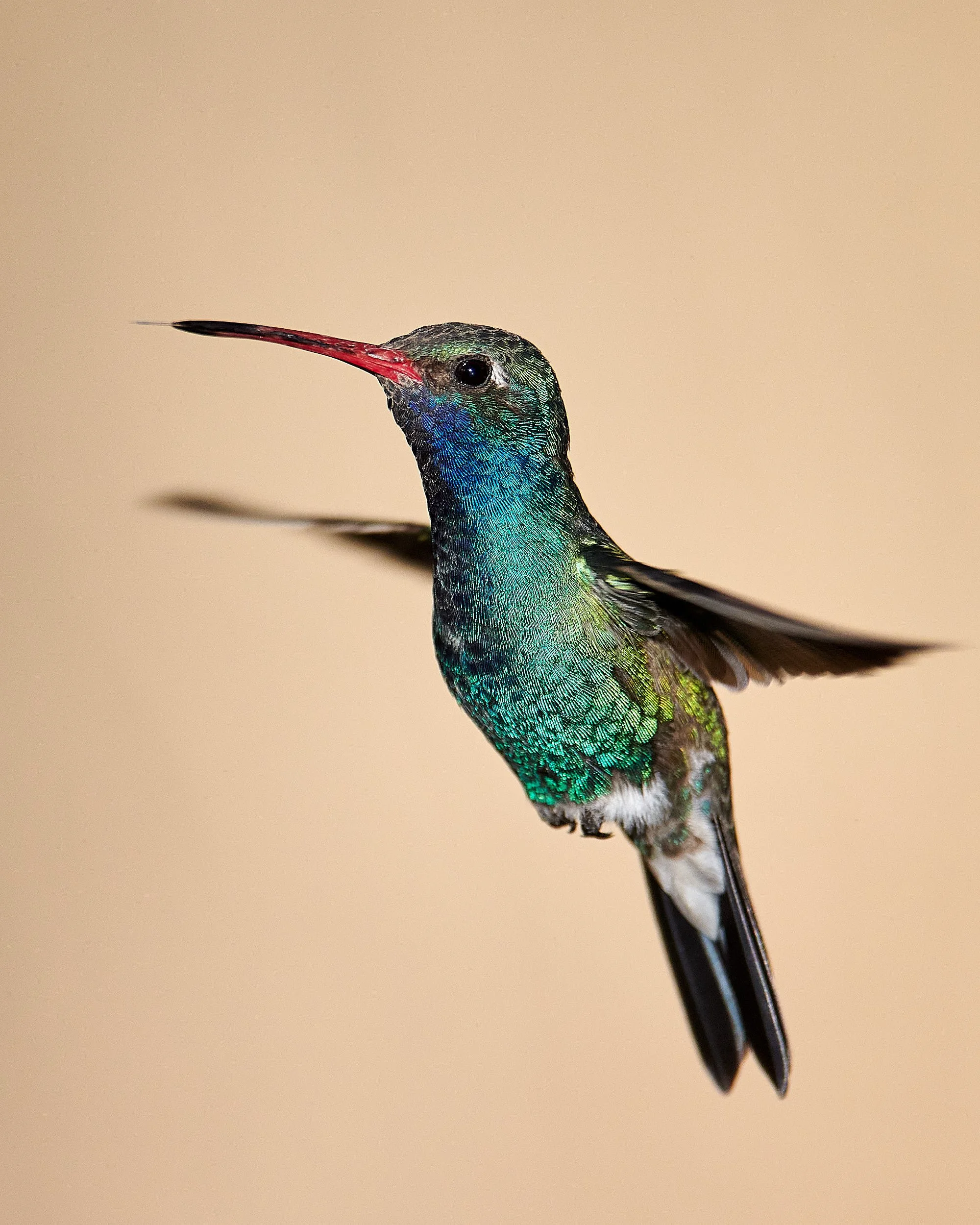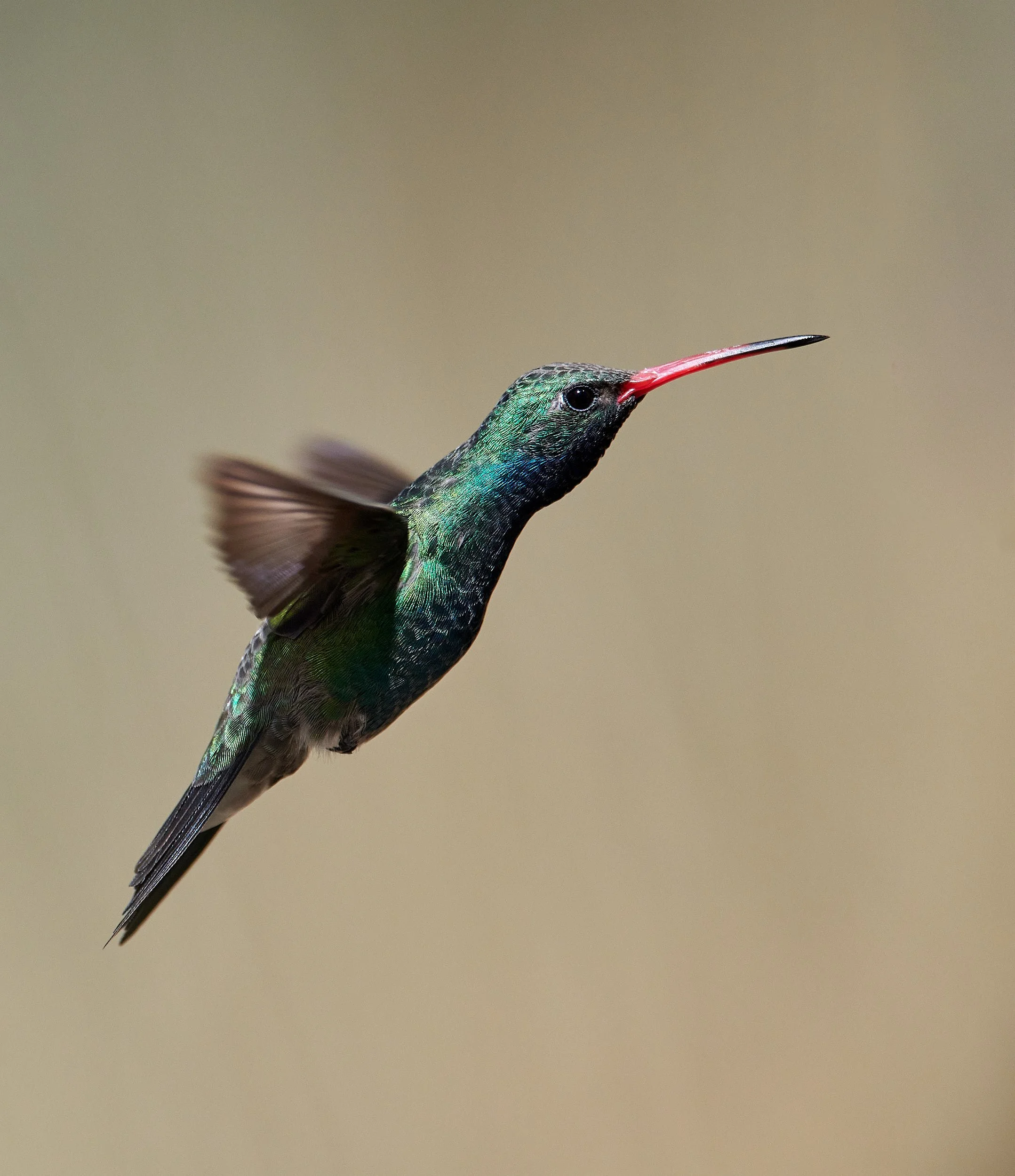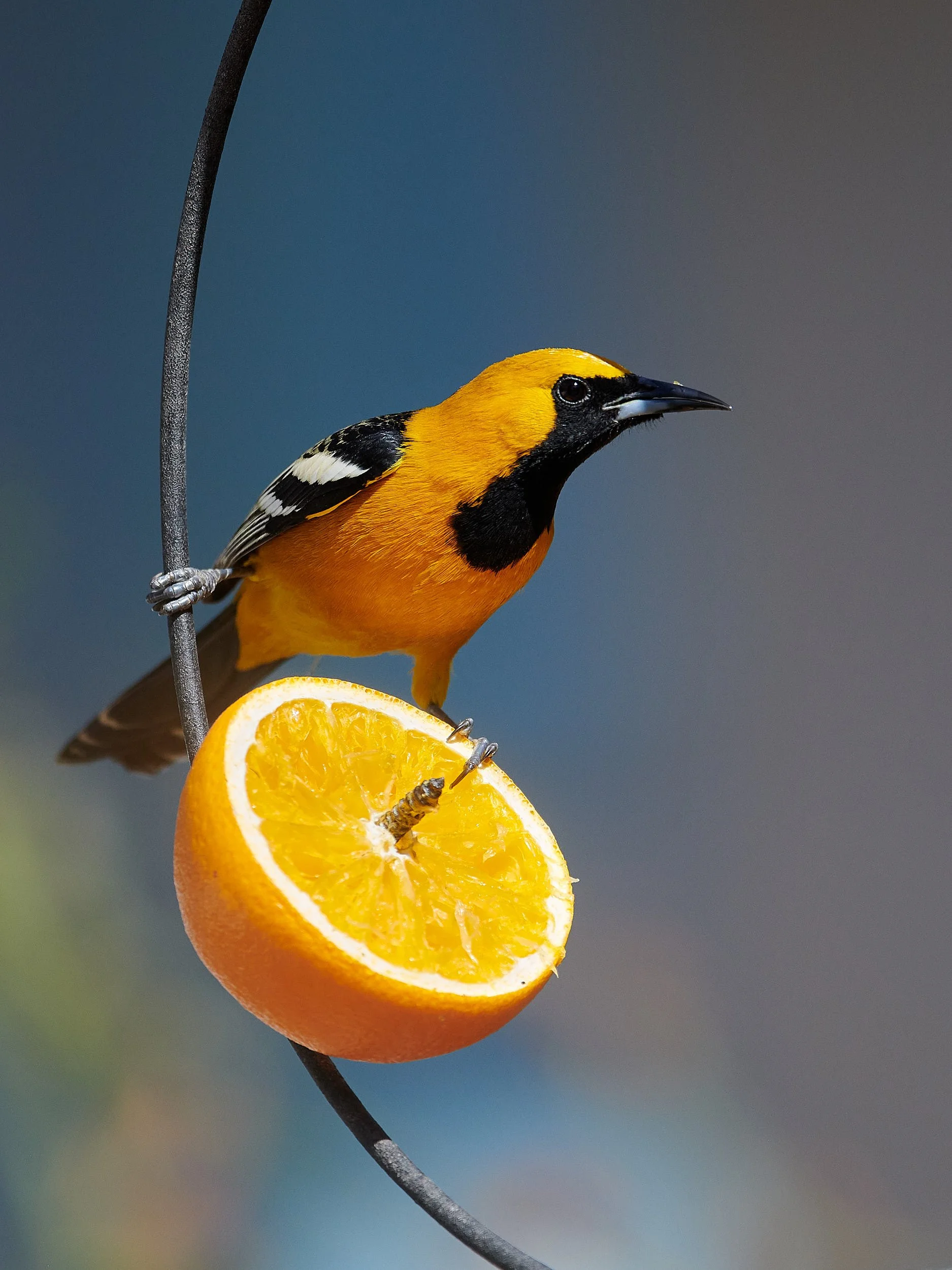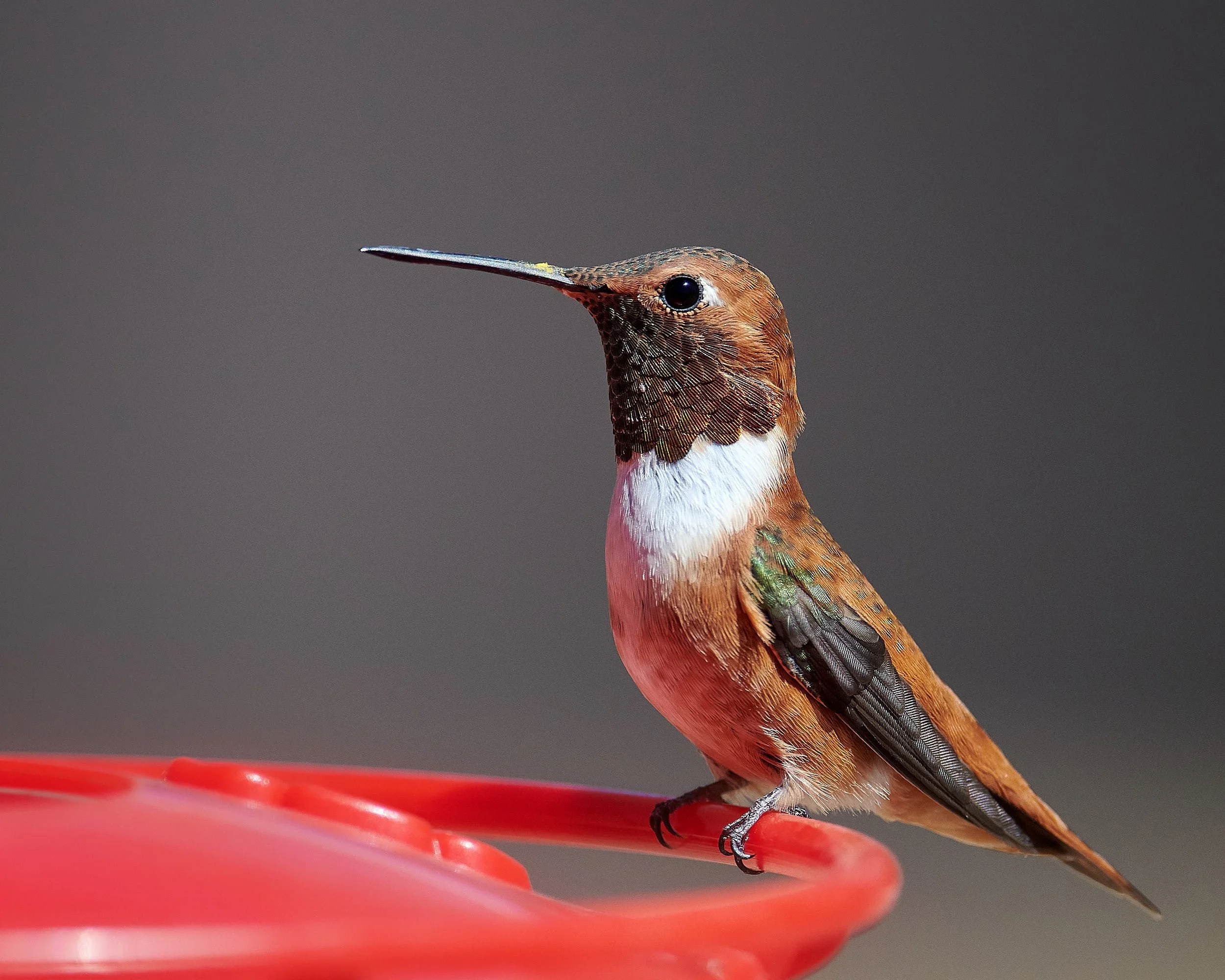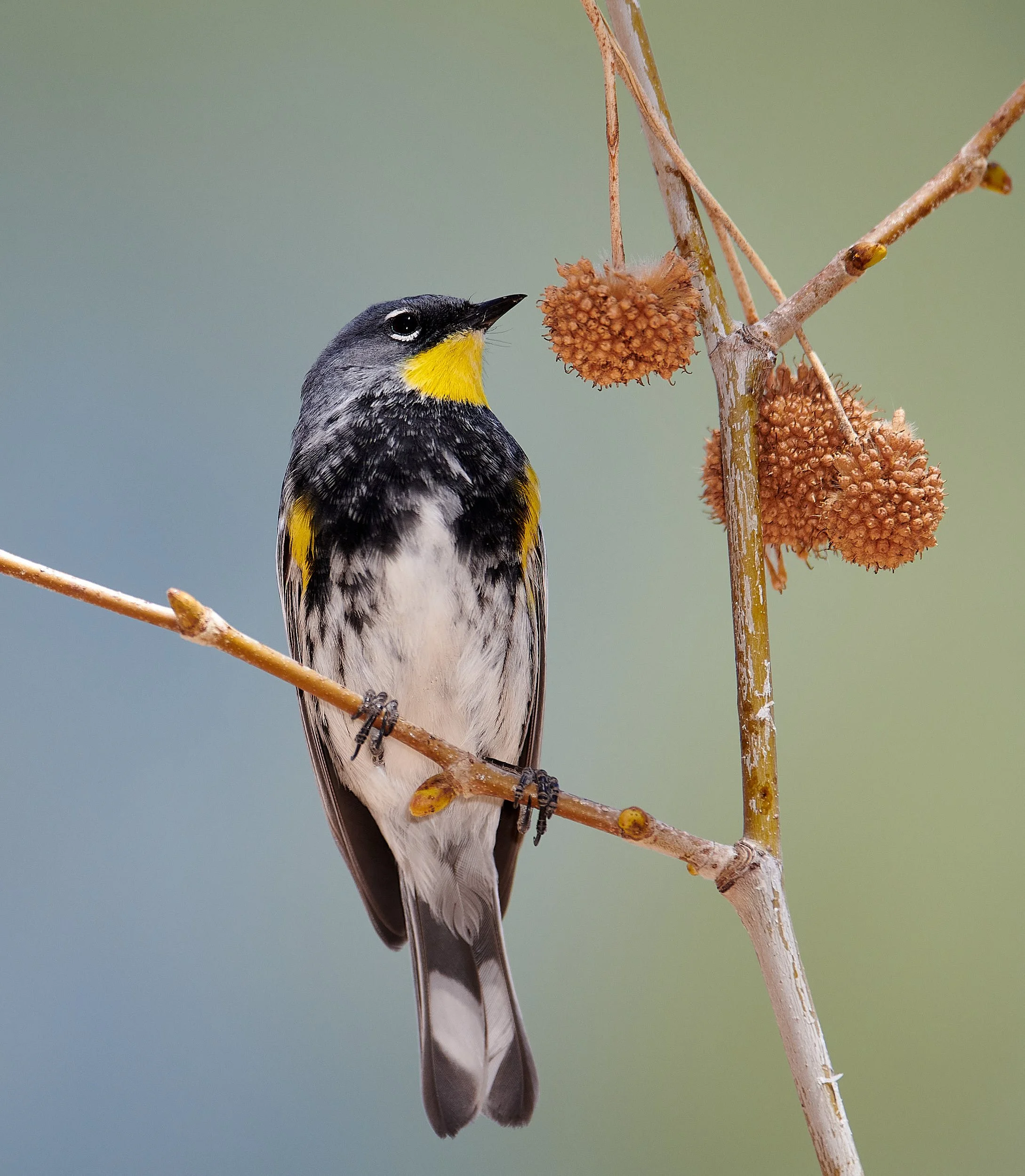Southern Arizona: April 2022
Male Broad-billed Hummingbird
Extraordinary Biological Diversity
Southern Arizona contains two Sonoran Desert subdivisions: the low, hot, very dry, winter-rainfall Lower Colorado River Valley and the comparatively lush, higher and colder, bi-seasonal-rainfall Arizona Upland. Towards the east, these Sonoran Desert subdivisions encounter several major biogeographic zones - the Sky Island Region, Chihuahuan Desert, Sierra Madre Occidental, Rocky Mountains and Colorado Plateau. This complex assembly supports a spectacular array of diverse fauna and flora.
Background
Ecologists recognize about 10 biomes - widespread classes of habitats identified by their dominant plant life-forms. Arizona & adjourning NW Mexico contain almost all the world’s biomes, from tundra to tropical dry forest. Important influences on the ecology of southern Arizona include: (1) deserts, (2) bi-seasonal rainfall, (3) Sky Islands
Deserts
North American has four major deserts: Great Basin, Mojave, Chihuahuan & Sonoran. The latter two occur in southern Arizona and both are rich in species. The Chihuahuan Desert lies at fairly high elevation and hard winter freezes are common. Rainfall is mainly in the summer. It’s vegetation comprises low shrubs, succulents and small cacti. The Sonoran Desert has mild winters, receives bi-seasonal rainfall and, unlike the other deserts, has legume trees and large columnar cacti.
Bi-seasonal rainfall
Yearly rainfall in southern Arizona is very variable. Yuma, in the SW, receives about 3 inches, whereas Portal, situated in the Chiricahua Mountain foothills of SE Arizona, gets 20 inches on average. Winter rainfall (December - February) is usually less than the summer monsoons (July - September). Many of the desert perennial plants are derived from ancestors in the tropical thornscrub to the south and their life-cycles are attuned to summer rain. Sonoran Desert annuals are typically oriented to winter rains.
Sky Islands
Between 6 & 35 million years ago, plate tectonics created the US West’s Basin and Range topography that extends into southern Arizona. Arizona’s Sky Island region gets its name from about 65 isolated mountain ranges harboring oaks, pines and other conifers that arise like islands from a sea of desert and grassland. Five of the ranges exceed 9,000 feet in altitude.
From: Arizona-Sonora Desert Museum
The Plan
A Covid shut-down scuttled our March, 2020 plans to visit southern Arizona. Now, two years later, we felt the time was right. We decided that birds would be the main focus of our month-long trip and designed the trip itinerary based on Tucson Audubon Society’s excellent publication entitled “Finding Birds in Southeast Arizona”.
Male Broad-billed Hummingbird
Our Route
Departing from San Francisco Bay, we over-nighted in Barstow and reached Organ Pipe Cactus National Monument the next afternoon. From there, we journeyed east, always south of Tucson until we reached the Chiricahua Mountains at the New Mexico border. Tucson was visited on our westward return journey. As usual, we travelled in our Sportsmobile.
Organ Pipe Cactus National Monument
Alamo campground has 4 sites - first come, first served. Bring your own water. We contacted our good friends Anita and John, who live nearby and they drove out in their Sprinter RV to camp with us. It was delightful to have their company. Both Anita and John have spent most of their adult lives in Alaska. John abandoned a philosophy PhD in favor of fishing in Alaska and, after a few years, procured his own boat. Although he has retired from commercial fishing, he continues his other profession - writing. Every evening after dinner he read a piece of his poetry or prose to us - a true treat!
So This
So this is what
it all comes to….
Sharing a house
with a one-eyed cat
and a deaf dog,
watching another sunrise.
God, what did I do
to deserve this?
I don’t know
but thank you.
(Reproduced, with permission)
Giant Columnar Cacti
Organ Pipe Cactus (Stenocereus thurberi)
The species originated in the tropics of Central America and is intolerant of sub-freezing temperatures. After the last Ice Age, It slowly migrated north as Earth’s climate warmed, reaching North America 3,500 years ago. The Monument represents the northern limit of the species’ distribution. Here, the cactus favors warm locations such as dark volcanic rocks on SE-facing hillsides. It is slow growing, taking about 20 years to reach 3 feet in height and can live more than 150 years. White flowers are produced from the top third of the stems in June. The blooms open only at night and are pollinated by lesser long-nosed bats & Mexican long-tongued bats that migrate north after wintering in tropical Mexico. The sweet, red fruit are very tasty and are sometimes commercially harvested.
Saguaro (Carnegia gigantea)
The high esteem O’odham people have for saguaros is reflected in their many creation stories for this plant. In the traditional view, saguaros are not plants; they are another form of humanity. The species’ range is almost completely restricted to Southern Arizona and Mexico’s western Sonora. Plants may grow to 60 feet in height. Flowers are white, bloom in May/June, open at night and remain open until mid-afternoon the next day. Like the organ pipe cactus, bats feed on the nectar (energy) and pollen (protein) and thereby pollinate the flowers. However, research has shown that pollination is also performed during the day by native bees, white-winged doves and others. The fruit are rosy colored with red pulp; the seeds are dispersed by seed-eaters such as the house finch, white-winged dove and Gila woodpecker. Seedlings initially grow very slowly and are extremely vulnerable to predation and adverse environmental conditions. Nearly all survivors are located beneath the canopies of nurse plants. Significant establishment of seedlings requires several consecutive years of mild, wetter weather. Such conditions occur only a few times a century in the Sonoran Desert. This results in saguaro populations with only a few size / age classes (called cohorts), often several decades apart in age.
From: A natural history of the Sonoran Desert. Eds M.A. Dimmit, P.W. Comus and L.M. Brewer. Arizona-Sonora Desert Museum Press.
Buenos Aires National Wildlife Refuge
This large Refuge is only a few hours drive from Alamo campground. Managed by US Fish & Wildlife Service, it contains desert grassland, mesquite groves, riparian woodland, wetlands and sycamore/oak mountain canyons. The varied habitats make great wildlife viewing; special species include pronghorn antelope and gray hawks. Endangered masked bobwhite quail have been reintroduced to the refuge but remained out of our sight. Camping is primitive and free. We birded Arivaca Creek & Arivaca Cienega and rehydrated at Arivaca’s La Gitana Cantina – the oldest bar in Arizona.
Top row: Gray Hawk. Bottom row: Northern Cardinal (left), Vermilion Flycatcher (right)
Sky Islands
Sky Islands are isolated mountain ranges in southeastern Arizona and northern Mexico. The US portion of the Sky Island Region constitutes about 20,000 square miles. For every 1,000 feet gain in altitude, precipitation increases about 4.5 inches and temperature drops 4°F. Some of the mountains rise more than 6,000 feet above the surrounding desert floor making the lowlands and high peaks drastically different. The mountains offer relief from heat and thirst and provide additional options for nutrition and shelter. They act as biological “stepping stones” for montane species to disperse over time. Plants and animals living in the mountains could never survive in the surrounding deserts.
The Sky Island Region connects two very different mountainous regions, the subtropical Sierra Madre of Mexico and the temperate Rocky Mountains of the United States. The mixing of these southern and northern biotas is truly unique. You can see incredible plant and animal diversity in only a few miles. It is easy to visit both desert and alpine areas in the same day.
Nearly 500 bird species have been reported from SE Arizona, more than half of the entire bird fauna of the US. Birds associated with cool conifer forests breed high in the mountains, while birds of Mexican origin breed in the lower oak/pine woodlands. Tropical pine-oak specialists include the elegant trogon, Mexican spotted owl and Arizona woodpecker. Desert and grassland have many distinctive avian species. Spring and fall bring a wealth of migrants and some species overwinter in the lowlands.
Sky Island fauna is also particularly rich for snakes, bees, bats and snails. Endemic mammals include the Chiricahua fox squirrel. Jaguars are rare visitors.
Sky Island Region of SE Arizona
From: Coronado National Forest website
Madera Canyon: our first Sky Island
Madera Canyon lies within the Santa Rita Mountains of the Coronado National Forest. The highest peak is Mt. Wrightson (Old Baldy) at 9,432 feet. There are numerous hiking trails, several lodging options and Bog Springs campground (our home for the next 5 days). Sixteen hummingbird species have been reported at Madera Canyon so we promptly set up nectar feeders at camp. We explored the canyon’s riparian woodland and hiked up spur-hugging trails to higher elevations in the Mt. Wrightson Wilderness. Oak woodland transitions to Pine-Oak as one ascends and we encountered many plant species that were new to us Californians.
Santa Rita Lodge maintains a popular feeding station for birds (water, nectar, suet, fruit, seeds) and people (coffee, ice-cream). Wild turkeys & humans (including us) were frequent visitors.
Male Arizona Woodpecker (left), Male Hepatic Tanager (right)
Male Broad-billed Hummingbird
Broad-billed Hummingbirds (male and female)
Coati
Coatis, also known as coatimundis, are procyonids as are raccoons and ringtails. The name "coatimundi" comes from the Tupian languages of Brazil, where it means "lone coati”. They are native to South & Central America and the southwestern US and typically inhabit the riparian woodland of mountain canyons. Coatis are diurnal omnivores and dig in the soil and leaf litter using their long claws or their noses to turn up grubs and worms. They also turn over rocks with the front paws to search for invertebrates, lizards and snakes. Coatis are very social, living in bands of up to 30 individuals comprised of females and their young. Adult males are usually excluded. We twice encountered a coati, both times the animal was foraging around habitation.
Rivoli’s Hummingbird (formerly Magnificent Hummingbird), male and female
Patagonia, AZ
Located about 18 miles north of the U.S.-Mexico border, Patagonia town (population 823 in 2020) is situated at over 4,000 feet elevation between the Santa Rita and Patagonia Mountains in the riparian corridor of Sonoita Creek. The town has been described as a quirky mix of artsy shops, railroad history and western style. Patagonia’s website states their community’s vision is to continuously develop their nature-based economy. To that end, Patagonia has two famous birding attractions - the Tucson Audubon’s Paton Center for Hummingbirds & the Patagonia-Sonoita Creek Preserve. We visited both, had hamburgers in the Wild Horse Saloon, sipped coffee at Gathering Grounds and shopped for distinctive clothing.
Audubon’s Paton Center is considered the best place in USA to see a Violet-crowned Hummingbird. Webcams keep the world tuned in. The resident bird expert (Louie) is an outstanding teacher. A path links the Center to the Nature Conservancy’s Patagonia-Sonoita Creek Preserve which has self-guided trails. Cottonwoods and willows line the perennial stream while mesquite bosque, open fields and a cienaga expand the habitat options. Gray hawks were around.
Black-chinned Hummingbird, male (top)
Black-chinned Hummingbird, female (bottom left) and male (bottom right)
Costa’s Hummingbird, male (top left), Violet-crowned Hummingbird (top right), Costa’s Hummingbird, male (bottom)
Hooded Oriole, male
Cienega with cottonwood trees, Sonoita Creek
Gila Woodpecker, male (left), Sonoita Creek (right)
Huachuca Mountains
This Sky Island in the Coronado National Forest has a high point of 9,466 ft and several deep, moist canyons that harbor a variety of montane and riparian habitats. The mountain range is oriented in a northwestern direction giving it more north-facing slopes and perhaps a somewhat cooler climate than some of the other Sky Island mountain ranges with similar elevation. It is prime birding country. Canyons named Huachuca, Ramsey, Carr, Miller or Ash will set many birders’ hearts aflutter. We disperse camped in Miller Canyon and hiked the creek trail to Beatty’s Guest Ranch and Orchard. Here, in 2002 and 2006, 14 hummingbird species were observed (a one-day site US record for hummers). Unfortunately, a winter storm had moved through the West Coast and was now whipping up gale-force winds around our campsite. We dropped our Sportsmobile poptop and slept “downstairs”. Next day the wind continued as we visited the SE Arizona Bird Observatory in Ash Canyon. This center is well designed for photography and introduced us to the delightful Lucifer Hummingbird.
Top row: Beatty’s Ranch & hummingbird feeder station (left), Miller Peak Wilderness (right)
Bottom row: Our Miller Canyon camp (left), Lower Miller Canyon (right)
Rufous Hummingbird, male (top), Rufous Hummingbird, female (bottom)
Top row: Pipevine Swallowtail (left), House Finch, male (right)
2nd row: Nashville Warbler (left), Lesser Goldfinch (right)
3rd row: Ladder-backed Woodpecker, male, Ladder-backed Woodpecker, female
4th row: Calliope Hummingbird, male (left), Painted Redstart (right)
5th row: Ground squirrel (left), Chipping Sparrow (right)
6th row: Rufous Hummingbird (left), Lesser Goldfinch (right)
At Ash Canyon, a male Lucifer Hummingbird bathed in water and then dried himself by shaking his wings and grooming.
Cave Creek Canyon, Chiricahua Mountains
Easter was approaching and we journeyed east to the Chiricahua range in order to pre-empt the holiday rush to desirable, cool locations. It was a wise move; we managed to secure an excellent site at Sunny Flat campground in the heart of Cave Creek Canyon, Coronado National Forest.
The Chiricahua Mountains are a massive, forested Sky Island with habitats ranging from semi-desert grassland and arid Chihuahuan desertscrub to forests of Engelmann spruce and alpine fir at the summit of Chiricahua Peak at 9,795 feet. The great size of the range (nearly 40 miles long and 20 miles wide) and its proximity to the Sierra Madrean ranges in Mexico means that a wide variety of bird, animal and plant life found nowhere else in the US can be seen here.
In addition, the Cordilleran Gap (the lowest elevation in the 4,500 mile continental spine of the Rockies/Sierra Madre Cordillera) is close by and allows elements from the Great Plains (e.g.: wintering sparrows, buntings, longspurs) to enter from the east.
From: Cave Creek Canyon. Eds W. Brown and R. Peters
Cave Canyon Geology
In recent geologic times, as the Pacific plate subducted under the North American continental plate, volcanic activity resulted in broad lava flows containing quartz-rich dacite, rhyolite tuff, silica and other minerals which created the marvellous purple and red cliffs of Cave Creek Canyon.
Cave Creek & Canyon
Life in Cave Creek Canyon
Idyllic Sunny Flat campground has 13 sites, all first-come, first-served. With the pressure of Easter, the lucky few who had procured a site were generally staying put for some time. Neighbors started up conversations and shared stories. Betty & Terry have a Sportsmobile (their 2nd) and we soon bonded. For the last 23 years they have spent close to 6 months on the road each year, traveling the length and breadth of western US. For Betty & Terry, each day is another adventure. We enjoyed regular sundowner sessions with them and loved their vast travel knowledge and the stories they related. Dianne also participated. She is a keen naturalist and worked in a National Park for a decade before moving to a retirement complex in Arizona. Dianne feels most comfortable when parked in wild places in her A-frame camper. We appreciated her independent spirit, friendly nature and environmental interests.
Trevlyn remarked that she had never seen so many long camera lenses in one place. The truth is that Cave Creek Canyon was dripping with birders. The serious variety dress a certain way and murmur in whispers. They identify species by sound. It was abundantly clear that spotting an elegant trogon was a mark of distinction, a rite of passage. The south fork of Cave Creek is justifiably one of the best US locations for elegant trogon. Other delights include Arizona woodpecker, sulphur-bellied flycatcher, dusky-capped flycatcher, plumbeous and Hutton’s vireo, painted redstart and hepatic tanager. We joined the line of birders that walked, like Camino de Santiago pilgrims, along the south fork trail. Failure, not an elegant trogon to be seen. Then one morning at camp, Jumbo was enjoying his morning coffee when a bright red, green and white bird flashed by. An elegant trogon, no less! Jumbo’s chest swelled and his importance grew. Life was good.
Birding along road by South Fork of Cave Creek
Blue-throated Mountain-gem, male (all rows)
What is this male Scott’s Oriole doing? (top left), Black-headed Grosbeak, male (top right)
Clever bird! (bottom left), White-winged Dove (bottom right)
Acorn Woodpecker, male (left), Red-faced Warbler - to prove we saw this uncommon species! (middle), Serious birder (right)
Mexican Jay (left), White-breasted Nuthatch (middle), Yellow-eyed Junco (right)
Pinery Canyon
Unpaved Forest Road 42 ascends from Cave Creek Canyon to the crest (Onion Saddle) of the Chiricahua range and descends westward along Pinery creek canyon. It allowed us to study changes in vegetation with altitude and obtain sweeping vistas of Sky Island terrain. We disperse camped along Pinery creek, amid stately sycamore and cottonwood trees. The riparian woodland attracted many birds.
Yellow-rumped Warbler
Empidonax Flycatcher
Yellow Warbler
House Wren
Broad-tailed Hummingbird, female
Broad-tailed Hummingbird, male
Cochise Stronghold Camp, Dragoon Mountains
After camping along Pinery Creek, we planned to visit Chiricahua National Monument, an area of geologic interest and scenic beauty. Unfortunately the campground was full and the general vibe was hectic. We opted out, driving west to the Dragoon range - another Sky Island but quite different from others that we had visited.
Cochise Stronghold campground is in a extraordinary canyon complex that served the famous Apache Indian leader, Cochise, as a refuge against his enemies. The history surrounding Cochise & the Apache Nation is tragic and sad. However, their granitic stronghold is truly uplifting. The dramatic topography, flowering succulents and afternoon light made for an unforgettable experience. We hiked the Cochise trail and discovered plants of both the Upper Sonoran and Chihuahuan Deserts. The area is a notable climbing destination.
View along Cochise trail
Arizona-Sonora Desert Museum
After our stay at Dragoon, we relocated to the Gilbert Ray Campground near old Tucson. It is close to the Saguaro National Park, the Tucson Mountain Park and the renown Arizona-Sonora Desert Museum. Betty and Terry were already at Gilbert Ray and they reserved a site for us. The campground is basically an extension of Saguaro National Park which is a glorious sample of the Upper Arizona subdivision of the Sonoran Desert. Cacti and saguaro were blooming, cactus wren nested in chain-link cholla, Gambel’s quail wandered through camp and curve-billed thrashers warbled aimlessly. The Desert Museum is amazing, especially the succulent exhibits. It is a must-see if you are anywhere near Tucson.
Buckhorn cholla
Cactus Wren at nest (top), Gambel’s Quail (bottom)
Trip Reflections
South Arizona’s birdlife are a joy to behold and we identified a total of 119 bird species, of which 11 were hummingbirds. The sound identification aide in Cornell’s Merlin birding app proved very useful, particularly when entering an area where one is unfamiliar with the avifauna. We will return to Arizona, perhaps during the fall monsoons for some wildflower botany.
In these Covid times, outdoor travel is a great way to safely connect with people - old friends and new. It seems that folk on the backroads generally embrace a culture of mutual respect and goodwill. They appreciate nature and the simple pleasures in life. A great model to emulate.
Every day is a new adventure.

